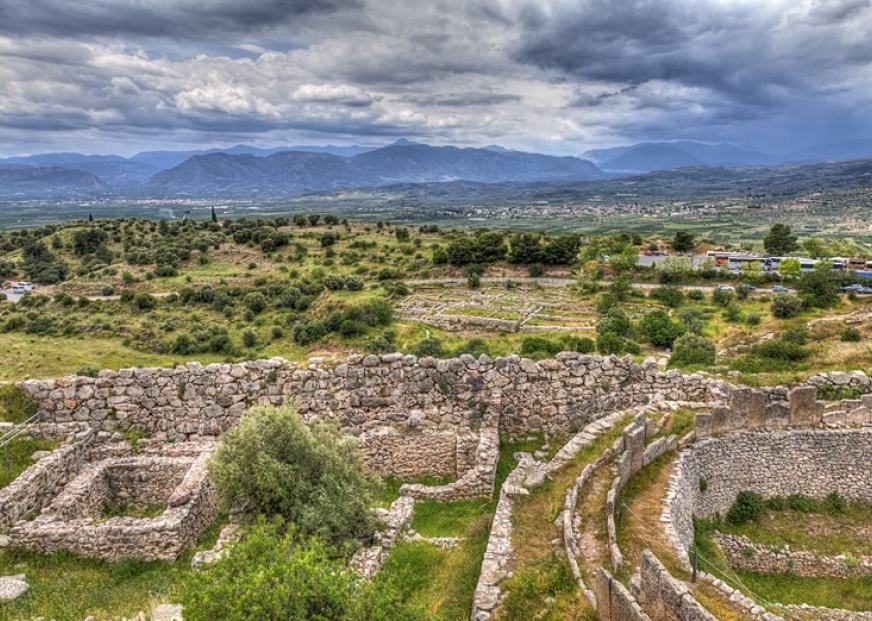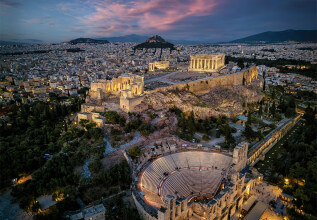3 MIN
TRAVEL TIPS
MYCENAE

 Two fierce lions, staring at each other, decorate the main gate of these monumental walls. This gate leads to the magnificent palace of Mycenae. The remnants of the palace are dated between 1250 B.C and 1200 B.C, but scientists believe that this palace replaced another smaller and more primitive royal residence.
Two fierce lions, staring at each other, decorate the main gate of these monumental walls. This gate leads to the magnificent palace of Mycenae. The remnants of the palace are dated between 1250 B.C and 1200 B.C, but scientists believe that this palace replaced another smaller and more primitive royal residence.
 The palace consisted of official rooms, private royal apartments, a bath and many guard and store rooms. The corridors and the chambers were decorated with colorful frescoes of plants, animals and everyday life stills. But the most important indicators of the Mycenaean civilization were the graves that were discovered in Mycenae. A large amount of shaft and “tholos” graves were found inside and outside the walls of the acropolis.
The palace consisted of official rooms, private royal apartments, a bath and many guard and store rooms. The corridors and the chambers were decorated with colorful frescoes of plants, animals and everyday life stills. But the most important indicators of the Mycenaean civilization were the graves that were discovered in Mycenae. A large amount of shaft and “tholos” graves were found inside and outside the walls of the acropolis.
 The first type of graves is supposed to be an early kind of burial, the findings of which are dated between 17th and the 16th centuries B.C, while the tholos tombs were a more advanced and impressive type of royal burial, created under the influence of the Minoan and the Egyptian art, that became known to the Mycenaean people through their commercial journeys between the 16th and 13th centuries. The excavations in the royal shaft graves and the “tholos” tombs revealed golden and silver swords, daggers, precious artifacts and other beautifully carved burial goods that would accompany each deceased to his death journey.
Another significant feature of the Mycenaean domination is the prevalence of the Linear B’ script. This script is considered to be an “updated version” of the Minoan Linear A’ script and its syllabary contained both ideographic and syllabic signs. The Linear B’ manuscripts reveal an early form of ancient Greek and they were spotted not only in different Mycenaean cities across the country but also in surprising places such asStonehenge. Undoubtedly, these discoveries pinpoint the extent of the power, the wealth and the ability of the Mycenaean people and bolster the significance of this ancient civilization.
The first type of graves is supposed to be an early kind of burial, the findings of which are dated between 17th and the 16th centuries B.C, while the tholos tombs were a more advanced and impressive type of royal burial, created under the influence of the Minoan and the Egyptian art, that became known to the Mycenaean people through their commercial journeys between the 16th and 13th centuries. The excavations in the royal shaft graves and the “tholos” tombs revealed golden and silver swords, daggers, precious artifacts and other beautifully carved burial goods that would accompany each deceased to his death journey.
Another significant feature of the Mycenaean domination is the prevalence of the Linear B’ script. This script is considered to be an “updated version” of the Minoan Linear A’ script and its syllabary contained both ideographic and syllabic signs. The Linear B’ manuscripts reveal an early form of ancient Greek and they were spotted not only in different Mycenaean cities across the country but also in surprising places such asStonehenge. Undoubtedly, these discoveries pinpoint the extent of the power, the wealth and the ability of the Mycenaean people and bolster the significance of this ancient civilization.
Article by www.museummasters.gr/en/


